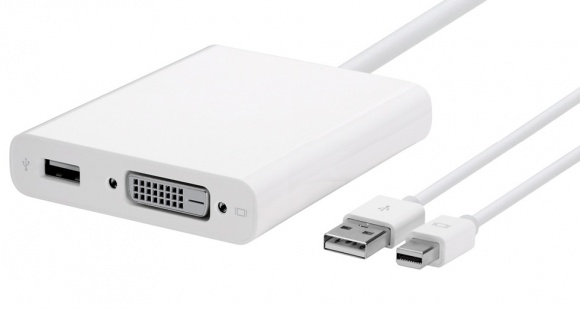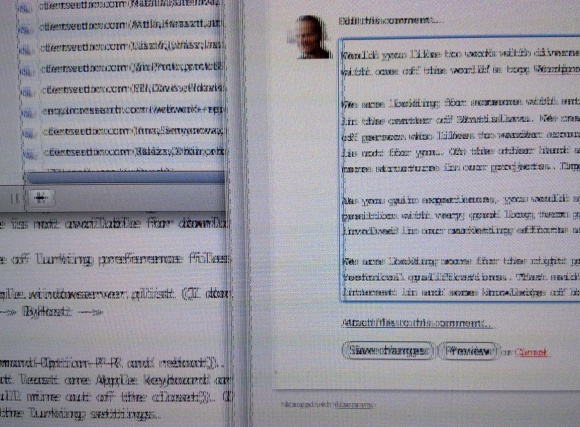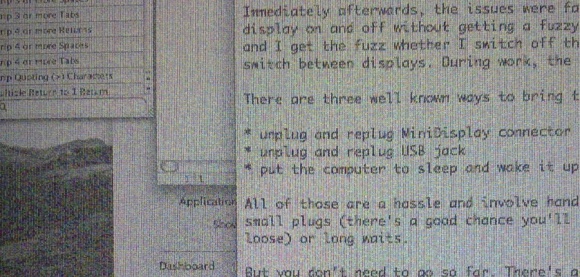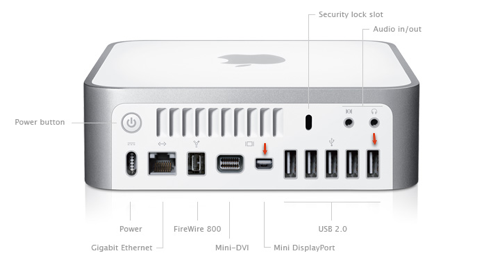Yes, everything awful you’ve heard about these adapters is true. They don’t really work right, under Mac OS X. The strange thing is that those who’ve turned their Mac Minis into either Windows XP or Linux rigs do not have trouble with the adapter. So it’s not really hardware related. A bit embarassing that the Apple engineers can’t get their own gear working. Another senior engineer transferred to the iPhone video driver department?

Apple Mini DisplayPort Dual Link DVI Adapter MB571Z
Here’s what recent reviews on Apple’s own store say (just two of two hundred):
Flicker two or three times a day – GM, Dec. 9
I am a totally MAC fan. I love their stuff. It is always quality. This thing is awful. I depend on my monitor as I do a lot of photo work. I had an older macbook pro which had the DVI output. Ok, so I have buy a 100 adapter now, I am sort of ok with that. Then I find it takes up one of my USB ports as well. A little less happy, but give me a product that works. Now this… Two or three times a day I need to cycle this thing. Very poor. I really hope they fix this.
bad, bad, bad – VC, Dec. 9
This thing is junk. Sadly I have to re boot or put my computer to sleep at least three or four times a day because it goes out and comes back with the dreaded TV Snow we all hated as kids when the cable went out. Apple should have gotten this right by now. As a consumer and big spender on apple product I’m disappointed again. Windows 7 anyone? (Joke) Is Apple listening?

Apple Mini DisplayPort Dual Link DVI distortion
Straight out of the box with 10.5.6 and without SuperDrive EFI update 3.0 and Performance Update 1.0, the issues were extreme. Flickering every few minutes, with the screen lost in blurry double vision every half hour or so.
The only cure was to unplug the MiniDisplayport and replug it. Absurd remedy.
The adapter was on the fast track back to the store at that point.
The next step was to do some research about what is and what is not working. I updated everything to the most recent versions. It took about 4 cycles to get everything updates, but most of the changes were with iLife and iLife applications and Digital Raw compatibility. That was a good start. But there was one more step to go for success.
I’m on firmware 1.01. There is a 1.02 out there but apparently it can slow down response time for the screen. In this case, the cure might be worse than the disease. In any case the 1.02 firmware is not available for download.
The final step was to delete a couple of lurking preference files:
- Library —> Preferences —> com.apple.windowserver.plist (I don’t know why)
- User —> Library —> Preferences —> ByHost —> com.apple.windowserver.xxxxx.plist
Afterwards, you should the PRAM (Command-Option-P-R and reboot). Which I did, several times (I recommend keeping at least one Apple keyboard around for this sort of troubleshooting: I had to pull mine out of the closet). Often a single PRAM reset won’t ferret out all of the lurking settings.
Immediately afterwards, the issues were far less. I could even turn my HP LP3065 display on and off without getting a fuzzy distorted picture. That’s gone now and I get the fuzz whether I switch off the monitor and turn it on again or switch between displays. During work, the adapter works pretty consistently.

Apple Mini DisplayPort Dual Link DVI Snow
- unplug and replug MiniDisplay connector
- unplug and replug USB jack
- put the computer to sleep and wake it up
All of those are a hassle and involve hands leaving keyboards searching for small plugs (there’s a good chance you’ll knock Apple’s magnetic power plug loose) or long waits.
But you don’t need to go so far. There’s a trick which makes the issues just bearable. Just sleeping the screen is enough.
There are two easy ways to sleep the display:
- press Shift-Control-Eject. Your display will turn off and your hands don’t even need to leave the keyboard. If you use an Apple keyboard as your primary keyboard, this is the easiest and fastest.
- If you don’t use an Apple keyboard, there is a way around it. Go into System Preferences —> Exposé and Spaces —> Exposé and set the lower left corner to Sleep Display. I chose the lower left corner as it’s the one I visit least and it’s never too far out of the way.
After you’ve slept the display, you can almost immediately just move the mouse to wake it up. The work interruption isn’t more than a few seconds. Not exactly productive but a lot better than reaching for the plugs on the back of your computer.
The biggest time saver: if you think that you will be able to make this work perfectly yourself, give it up. I’ve even tried plugging the Dual DVI MiniDisplayport adapter’s USB connector into another USB hub. No better results. Perhaps it would help with a laptop. But on a Mac Mini do plug in the USB connector to the USB plug farthest away from the MiniDisplayport.

Mac mini back late 2009 Mini DisplayPort USB
If you are thinking about buying alternative hardware, forget it. You’ll need a male MiniDisplayport cable to female DisplayPort (1,2). That didn’t exist a couple of months ago but exists now. But from there you’ll need DisplayPort to Dual DVI. Dell has one but it also costs $100/€100 and also requires USB power. I.e. it looks like it wll cost more and be more complicated (extra MiniDisplayport to DisplayPort adapter).
If you are shopping for a new 30″ monitor to use with Apple computers, I highly recommend buying one of those which comes with displayport in. Currently the Dell UltraSharp 3008WFP looks like the only one. Samsung announced in 2007 but didn’t deliver: their 305T is still Dual DVI.
Personally, I find it incredible that Apple can’t or won’t fix this problem for their 30″ monitor users. It makes them look incompetent and I’m sure it’s costing them a lot of sales (I didn’t buy one of their high end notebooks as a consequence). I’m an old Mac hand so I was able to find the resources necessary to get this issue partially under control. It took hours, as if I were on Windows. What a new Mac user would feel, I can hardly imagine.
If all of the above prevents you from buying a Mac Mini or a Macbook Pro, so be it. If you do want to go Apple (and we do), plan to avoid going with 30″ monitors or buy Dell until this adapter issue is fixed.
Additional Resources
- Apple Support Threads 1837465 & (Warning: very long!) 1836042
- Gizmodo
- 9to5Mac
- DisplayBlog
- Michael Tsai (developer of EagleFiler and SpamSieve)
My 15″ Powerbook & Mini DisplayPort Improved

Alec Kinnear
Alec has been helping businesses succeed online since 2000. Alec is an SEM expert with a background in advertising, as a former Head of Television for Grey Moscow and Senior Television Producer for Bates, Saatchi and Saatchi Russia.



THANK YOU SO MUCH !
the “press Shift-Control-Eject” tip made my working-life bearable again!
you are my hero
I have the version 1.03 firmware on my Apple Mini DisplayPort to Dual-Link DVI Adapter.
Has problems. My Cinema HD 30″ has horizontal lines flickering all over. Does not resolve with the sleep-then-wake trick. :-( Tried a bazillion different remedies, to no avail.
I think the solution is HP ZR30w, or Dell UltraSharp 3008WFP.
Hi Eljay,
Sorry to hear about the bad news. I’m running clean with two 1.03 firmware versions. 1.02 did not resolve my problem. I’m running mine with two different HP LP3065 (bought a year apart). I’ve had success with both MacMini 2.0 GHz/9400 and MacBook Pro 2.26GHz/9400.
Try a different Mac. Swap the adapter again. Try the HD 30″ with other cards, computers. Isolate the weak component. You should be able to get this to work.
Making the web work for you, Alec
Hi Alec,
I do not think it is the computer (iMac 27). I’ve tried the MDP/DLDVI (MB571Z) adapter with the on two different computers (iMac 27, and Mac Mini).
Could be the Apple MDP/DLDVI adapter, which is my prime suspect.
Could be my particular Cinema HD 30″ being driven by the MDP/DLDVI adapter.
I ordered the Kanex MDPC30 adapter. (Thanks for whoever posted the URL to the Kanex product!) I will give that a try before getting the HP or Dell 30″.
Side note. I used to have a HP LP3065 at my previous job. I had 3 machines hooked up to it, and toggled between them with the 3 DVI inputs. I used Synergy to share one keyboard-and-mouse across the computers. Worked great, I liked LP3065 + Synergy much better than a KVM switchbox! Very nice monitor.
–Eljay
Hi Eljay,
Sounds like you are having a dreadful time. I’d look at selling off that Cinema Display to somebody who has a Mac Pro and getting another HP LP3065. They are still very competitively priced. Or alternatively the new Apple 27″ (then you don’t need a DVI display port adapter and can sell it off).
BTW, if you have a chance do try new dual-DVI cables. With one of my LP3065’s ordinary ones work, on the other I need the latest double insulated heavier duty dual DVI cables.
I have my HP L3065s calibrated with basICColor and an Eye One 2 and they reach photographic standards.
Making the web work for you, Alec
PS. Funny you mention Synergy. I did that for about six months but found that occasionally Synergy would disappear or crash my system so move to an external ATEN KVM four port switch (I’ve only ever used three) but with the dual dvi swap happening with HP switch.
Hi Alec,
Thanks for the info! :-)
I still have a Mac Pro G5, and a Mac Pro G4. Both of which I still use.
I’m not concerned about photographic calibration, but in my previous job worked with a lot of folks who did worry about that quite a bit. So I understand why/when that is important.
I already have a 27″. I prefer the 30″ for what I do as my main monitor, and the 27″ as the sidebar monitor. I do software engineering.
I also had some teething pains with Synergy, but I got all the kinks out. On Mac, I had to launch the Synergy process from a command line with some parameters which avoided the crashes. (2 of my machines were Mac.) On Windows, I had to fiddle with how Synergy launched to avoid problems. I also changed which machine was the Master (keyboard & mouse physically attached), and which two machines were the Slaves.
Thanks, –Eljay
Hi Eljay,
I like the 30″ better too. Vertical space is more important to me than horizontal alone.
Thanks for the Synergy tips. Now I’m really glad I bought the ATEN (I got the four station nice metal DVI version for about $120 and it looks solid and saves what sounds like days of troubleshooting). Which computer should be the master, btw?
Making the web work for you, Alec
PS. I’d still get rid of the problematic monitor. Life is too short for troubleshooting problematic hardware (I follow my own advice, and lived with a 2008 MBP 17″ just for the DVI output when I really wanted a 13″ MacBook Pro.)
Hi Alec,
The 30″ monitor wasn’t problematic before he MDP/DLDVI adapter. Had it for years, trouble free.
But I do suspect the MDP/DLDVI adapter as being problematic. Especially given the amount of outrage over it on the forums. And I am taking your advice and getting rid of that hardware! :-)
I’m glad the ATEN KVM is working for you. Sounds like the price on DLDVI+USB capable KVM has come way down. When I got the LP3065, the active DLDVI+USB KVM prices were about 60% of the cost of 30″ LCD monitors. Made the decision to go with the LP3065 due to its 3 inputs, which was great because the LP3065 is awesome! (I hope the ZR30w is also awesome. Since the ZR30w has DisplayPort, I’d get that… if push-comes-to-shove and the Kanex MDPC30 adapter doesn’t pan out.)
For my Synergy set up, I think I had my PowerMac G5 as the master, the Mac Pro and the HP box (Windows Vista, later Windows 7) as slaves. But those were my employer’s machines, so I can’t verify my memory. The tricky part was setting up the OS X Synergy daemon and its parameters correctly, since Synergy (the free one) had issues with later versions of OS X unless some parameters were added and Synergy had to be launched by the command line as a spawned off detached process. (I’m a Unix nerd at heart.)
I also have a MBP 17″ and MBA 13″. The MBP is practically a desktop unit. The MBA is very, very portable – love it! My first experience with an SSD – now I’m an SSD convert believer.
Sincerely, –Eljay
Hi Alec,
Just got the Kanex MDPC30 and hooked it up.
Initial experience is good. So far, none of the errant horizontal flickering garbage as seen with the Apple MB571Z.
Thanks bunches! –Eljay
Hi Eljay,
That’s valuable information. I would recommend that people get the Kanex instead based on your report and this test.
I can’t believe Apple has been putting their best customers (who else has 30″ monitors) through this kind of hell.
On the other hand, the Kanex solution is relatively recent. I see my strategy of pulling back and using a 2008 DVI MacBook Pro as my primary computer for 1.5 years was a good one. Early adopter blues.
Hi Alec,
Thanks! It’s a reasonable stopgap measure until…
… I’ll still probably get a DisplayPort capable 30″ (e.g., HP ZR30w or Dell UltraSharp 3008WFP) at some point.
Once my business is profitable. :-)
Sincerely, –Eljay
I have the smaller one, and run a wacom cintiq off it.
I was always astounded by the quality of the colour off the wacom. Brilliant blue, holds a candle to my Mitsubishi CRTs, and might even be better.
That is, unless you use the displayport adapter. Via DVI on my old laptop… beautiful. Displayport adapter… horrible washed out, dim, bad white balance, fringing on the screen edges, and the blue is sort of turquoise.
I am fairly ticked off, and will have to buy one that actually works. I guess because it’s having to actually process the signal and emit it via DVI, this thing is just weak, doesn’t put out much amps. Probably need to find some mains powered box…
just wondering why people would waste money on the duel link adapter? looks like a DVI adapter with USB beside it?…. anyways my HDMI miniport adapter works just fine on my 20″ monitor via HDMI to DVI conversion cable. and it works fine on the gramps 55″ LED LCD TV.
Hi Mark,
People need this adapter for monitors with 2560 x 1600 pixels (30″ cinema displays or in my case HP LP3065). There’s some Dell large monitors as well.
Making the web work for you, Alec
PS. The latest version of this adapter (Rev. 3 and further) actually do work.
Good news for me! I read a lot about this problem. I had the horizontal flicker problem on dark areas of my 30″ Cinema display. I thought it would never be solved. I went to my Brighton Apple Store and booked to see a genius. We plugged it all into my new 2011 Mac Mini. Problem Displayed!! He went and got their desks v1.02 Dual DVI adaptor and the problem went away. They then got a new one v1.03 from the shelves and it worked. Exchanged it with that problem solved.
So go to yr Apple Genius!
Tony
So… is it my understanding that buying Apple’s dual DVI adapter will solve the problem between my Apple 30″Cinema HD display, and new Macbook Air with miniport output (as long as I get v1.03)? Photography, Aperture, etc are important – so looking for a good high res solution. Or should I be looking for a Kanex MDPC30?
Hi BC,
Don’t the new MacBook Airs have a different video setup via Thunderbolt?
I’ve tested with the 2010 Mini DisplayPort MacBook Air (no problem) and 2009, 2010 13″ MacBook Pros but not with a Thunderbolt port yet.
Please let us know how it turns out.
@bc
I use a Thunderbolt 27″ display with my new MBA 13″. No problems (knock on wood).
I have both the Kanex MDPC30 and Apple MB571Z. I use the Kanex to hook up my Cinema 30″ to my iMac 27″. The MB571Z sits in my “Apple Box of Shame”, along with the puck mouse.
Anyone had experience with their Kanex MDPC30 and a Hazro HZ27WC 10-Bit, 27″ inch display ??
The Hazro runs native 2560 x 1600.